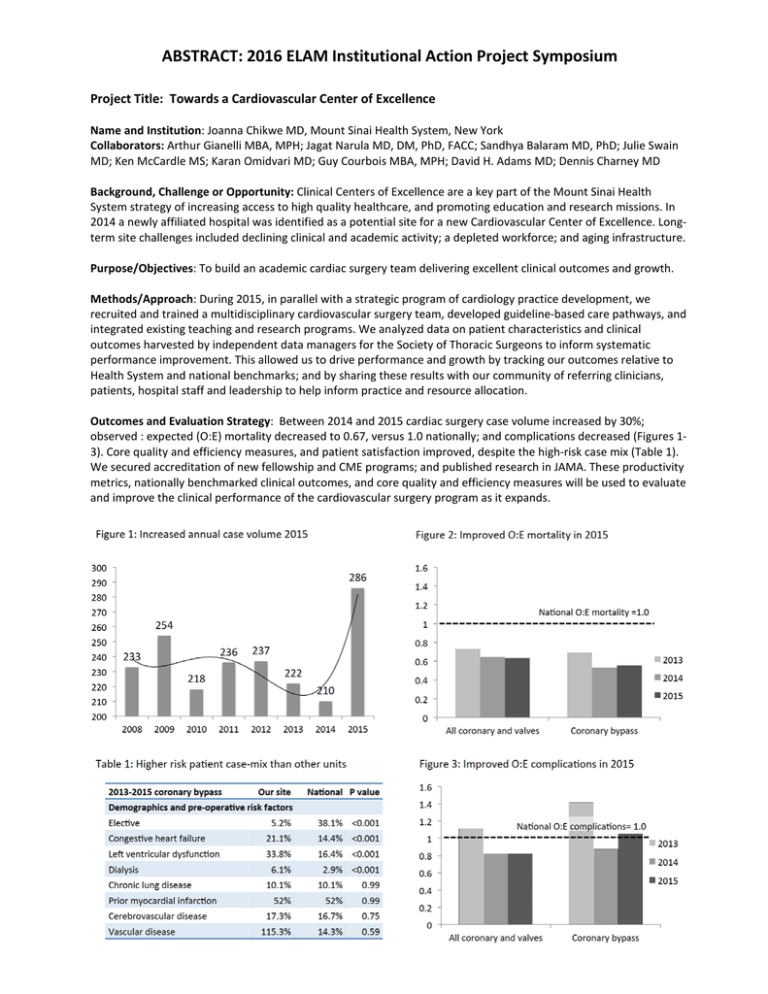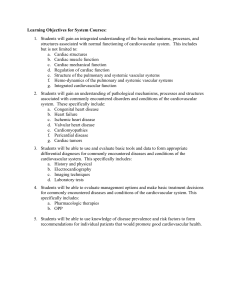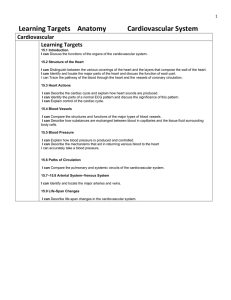ABSTRACT: 2016 ELAM Institutional Action Project Symposium Project Title:
advertisement

ABSTRACT: 2016 ELAM Institutional Action Project Symposium Project Title: Towards a Cardiovascular Center of Excellence Name and Institution: Joanna Chikwe MD, Mount Sinai Health System, New York Collaborators: Arthur Gianelli MBA, MPH; Jagat Narula MD, DM, PhD, FACC; Sandhya Balaram MD, PhD; Julie Swain MD; Ken McCardle MS; Karan Omidvari MD; Guy Courbois MBA, MPH; David H. Adams MD; Dennis Charney MD Background, Challenge or Opportunity: Clinical Centers of Excellence are a key part of the Mount Sinai Health System strategy of increasing access to high quality healthcare, and promoting education and research missions. In 2014 a newly affiliated hospital was identified as a potential site for a new Cardiovascular Center of Excellence. Longterm site challenges included declining clinical and academic activity; a depleted workforce; and aging infrastructure. Purpose/Objectives: To build an academic cardiac surgery team delivering excellent clinical outcomes and growth. Methods/Approach: During 2015, in parallel with a strategic program of cardiology practice development, we recruited and trained a multidisciplinary cardiovascular surgery team, developed guideline-based care pathways, and integrated existing teaching and research programs. We analyzed data on patient characteristics and clinical outcomes harvested by independent data managers for the Society of Thoracic Surgeons to inform systematic performance improvement. This allowed us to drive performance and growth by tracking our outcomes relative to Health System and national benchmarks; and by sharing these results with our community of referring clinicians, patients, hospital staff and leadership to help inform practice and resource allocation. Outcomes and Evaluation Strategy: Between 2014 and 2015 cardiac surgery case volume increased by 30%; observed : expected (O:E) mortality decreased to 0.67, versus 1.0 nationally; and complications decreased (Figures 13). Core quality and efficiency measures, and patient satisfaction improved, despite the high-risk case mix (Table 1). We secured accreditation of new fellowship and CME programs; and published research in JAMA. These productivity metrics, nationally benchmarked clinical outcomes, and core quality and efficiency measures will be used to evaluate and improve the clinical performance of the cardiovascular surgery program as it expands. Towards a Cardiovascular Center of Excellence Joanna Chikwe MD, Professor of Cardiovascular Surgery, and Site Chair, Mount Sinai St. Luke’s, Mount Sinai Health System, New York. Collaborators: Arthur Gianelli MBA, MPH; Jagat Narula MD, DM, PhD, FACC; Sandhya Balaram MD, PhD; Julie Swain MD; Ken McCardle MS; Karan Omidvari MD; Guy Courbois MBA, MPH; David H. Adams MD; Dennis Charney MD. Presented at the 2016 ELAM ® Leaders’ forum. Overview: We revitalized an academic cardiac surgery program in ManhaTan. In 2015 clinical volume and revenue increased by >30%, and outcomes improved compared to naZonal benchmarks, despite the significantly higher-­‐risk case-­‐mix. SystemaZc use of clinical outcomes data was a key element of strategy supporZng performance improvement, program growth, and metrics for conZnued program evaluaZon. 300 286 290 2013-­‐2015 coronary bypass Our site 280 Demographics and pre-­‐opera<ve risk factors 270 ElecZve 260 254 250 240 236 233 38.1% <0.001 1.2 CongesZve heart failure 21.1% 14.4% <0.001 1 Lee ventricular dysfuncZon 33.8% 16.4% <0.001 6.1% 2.9% <0.001 Chronic lung disease 230 222 218 220 Prior myocardial infarcZon 210 210 Cerebrovascular disease Vascular disease 200 2008 2009 2010 2011 2012 2013 2014 1.6 1.4 5.2% Dialysis 237 Na<onal P value 1.6 1.4 NaZonal O:E mortality =1.0 1.2 1 MSHS 0.8 2013 0.8 2013 0.6 2014 2015 0.6 10.1% 10.1% 0.99 52% 52% 0.99 0.4 17.3% 16.7% 0.75 0.2 0.2 115.3% 14.3% 0.59 0 0 2014 2015 All coronary and valves 2015 NaZonal O:E complicaZons= 1.0 Coronary bypass 0.4 All coronary and valves Coronary bypass Figure 1: Over a decade of declining cardiac surgery volume was reversed in 2015 Table 1: Our case mix remains significantly sicker than the na<onal case mix Figure 2: Observed : expected (O:E) mortality rates are bePer than na<onal benchmarks (doPed line) Figure 3: O:E complica<on rates decreased below na<onal benchmarks (doPed line). Background Methods Outcomes and Evalua<on Strategy Discussion • Clinical Centers of Excellence are a key part of the Mount Sinai Health System strategy of increasing access to high quality healthcare, and promoZng educaZon and research. • During 2015, in parallel with a strategic program of cardiology pracZce development, we recruited and trained a mulZdisciplinary cardiovascular surgery team, developed guideline-­‐based care pathways and a systemaZc performance improvement strategy. • Our clinical outcomes are shown above, compared against naZonal benchmarks, where the reference naZonal average = 1.0. Values less than 1.0 (below the doTed line) represent performance beTer than predicted by naZonal outcomes. • Over 12 months our new team achieved increased case volume and revenue; excellent clinical outcomes; and improved efficiency and paZent saZsfacZon. • We conZnuously audited longitudinal data on paZent mix and clinical outcomes harvested by independent data managers for the Society of Thoracic Surgeons. • Our case mix is significantly sicker than reported naZonally (Table 1). • Clinical outcomes analysis was a powerful tool for performance improvement, pracZce development, teambuilding, research, educaZon, and change. • In 2014 the newly affiliated St. Luke’s hospital in Harlem was idenZfied as a potenZal site for a new Cardiovascular Center of Excellence. • Historic site challenges were declining academic and clinical acZvity parZcularly in cardiac surgery (Figure 1); a depleted workforce; and aging infrastructure. Objec<ves • Our goal was to deliver excellent clinical outcomes and growth in the new Department of Cardiovascular Surgery at Mount Sinai St. Luke’s, New York. Right: This cardiac operaZng room team includes many new learners. Middle: A clinical report for our referring physicians, and one of our JAMA clinical outcomes papers. Far right: The whole team reviews our clinical outcomes, conferencing with teams across the Health System for the first Zme. • This allowed us to drive clinical performance and program growth by tracking our outcomes relaZve to Health System and naZonal benchmarks. • Importantly, we were able to share these results with our community of referring clinicians, paZents, hospital staff and leadership to enhance teamwork, inform clinical pracZce and program development. • In 2015 cardiac surgery case volume increased by 30% (Figure 1), observed : expected (O:E) mortality decreased to 0.67, versus 1.0 naZonally (Figure 2); and complicaZons decreased (Figure 3). • Quality, efficiency and paZent saZsfacZon metrics improved; new cardiac fellowship and CME programs were accredited, and we published research in JAMA. • This was despite a high-­‐risk case-­‐mix, a largely novice team, and a challenging healthcare environment. Summary • We built a strong cardiac surgery program supporZng a new Cardiovascular Center of Excellence. Clinical outcomes analysis helped establish a culture of team-­‐ work, academic success and clinical excellence; and metrics for future program improvement.








